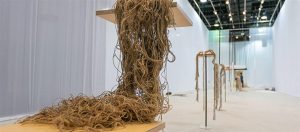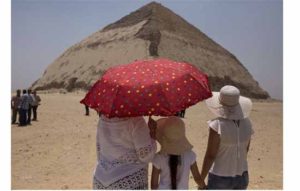‘I never thought they would be exhibited as an art piece. I was documenting my life in a diary during each period I spent in Gaza, long or short,’ he says
When Taysir Batniji left his home in Gaza City in 1993, he was only able to do so thanks to a laissez-passer issued by the Israeli authorities. Valid for one year, the travel document provided the then 27-year-old with the permission he needed to travel to the Italian city of Naples, where Batniji hoped to build on the studies he had already completed in the West Bank and to continue his education and progression as an artist.
The laissez-passer included all the details one might expect from a passport: a photograph and sections relating to the bearer’s name, sex, date and place of birth, the document’s date of issue and the issuing authority.
But when it came to the section entitled nationality, the laissez-passer described Batniji as neither Palestinian nor Israeli but simply as “undefined”.
Batniji eventually realised his dream of becoming an artist not in Naples but in Paris, where he has lived since 1996, the only member of his immediate family to have left the Gaza Strip.
In the intervening years, he has built a reputation as a nuanced chronicler of Gaza, where he returned to regularly and often until 2012, and of states of exile, displacement and what he describes as the cultural and geographical “between-ness” that now increasingly defines the lives of migrants the world over, Palestinian or otherwise.
Gaza to America: Home Away From Home
Even though it is 25 years out-of-date, Batniji still retains his laissez-passer as a reminder of his journey to the West, which is just one of the many things he shares in common with his cousins Kamal, Khadra, Sobhi, Ahmed, Samir, and Akram who are the subjects of his latest exhibition, Gaza to America: Home Away From Home.
Gaza to America was produced in 2017 as part of Immersion, a French-American Photography Commission, a program initiated by the Fondation d’entreprise Hermes together with the New York-based Aperture Foundation.
In it, Batniji retraces the journeys made by his cousins who decided to leave Gaza and who now have extended families of their own in California and Florida.
Their stories are captured in 143 works that include photographs, video portraits and interviews, drawings, old family photographs and objects such as passports that investigate the intimate functioning of this familial diaspora and the practices that define their identities as cousins, Gazans, Palestinians and Arab expats but also, increasingly as Americans.
“I do not pretend to reveal the lives of my American cousins in their entirety, in all their complexities, nor to present an exhaustive statement on the Arab and Palestinian diaspora in the United States,” Batniji writes in his introduction to the book that accompanies Gaza to America: Home Away From Home.
“These works are instead my impressions, born of these encounters, varying in their intensity, according to the context, place, and degree of interaction with these members of my family.”
‘This is a home away from home’
The title of the work comes from a conversation that Taysir Batniji had with his cousin, Khadra, who in response to the question “Do you feel at home in America?” answered: “My original home is Palestine. But this is a home away from home. Yes, like home.”
What follows is the result of two visits the Palestinian artist made to his cousins in California and Florida, the first of which lasted for three weeks and the second a-month-and-a-half, during which time he had to stay with family members, some of whom he had not seen since he was a child.
“What was strange in this experience was that tradition dictated that I had to stay with the family. There was no question that I would stay in a hotel or rent another house,” Batniji explains, speaking from Paris.
“I knew them, we share family ties, but at the same time, they were strangers to me and there were many things about their family lives that I didn’t know about and had to learn through conversations and interviews.
“It took time for us to become familiar, but through all this time I spent with them, there were always comparisons between me and them, so for me it was a kind of mirror.”
‘I never thought they would be exhibited as an art piece’
Accompanied by a monographic survey of Batniji’s work which spans the years 1999 to 2012, Gaza to America is one of five exhibitions that form the America Great Again! stand at the 49th edition of the world’s most famous and best-loved photography festival, Les Rencontres d’Arles.
America Great Again! includes some of modern and contemporary photography’s biggest beasts including Robert Frank, Raymond Depardon and Paul Graham, each of whom offer a foreigner’s perspective on modern and contemporary America, and each of whose exhibitions have been allotted serious real estate in the centre of Arles.
In contrast, Batniji’s work is currently being exhibited on two floors of the austere Chapelle Saint-Martin du Mejan, a 17th-century Baroque chapel that sits not far from the banks of the River Rhone.
While Gaza to America occupies the ground floor, the monographic survey of Batniji’s work occupies the first, including series such as the Bernd and Hilla Becher-inspired Watchtowers (2008) and Fathers (2006), which consists of photographs of commemorative portraits that hang in shops and workplaces across Gaza and Gaza Diary #3 (1999-2006).
www.thenational.ae




